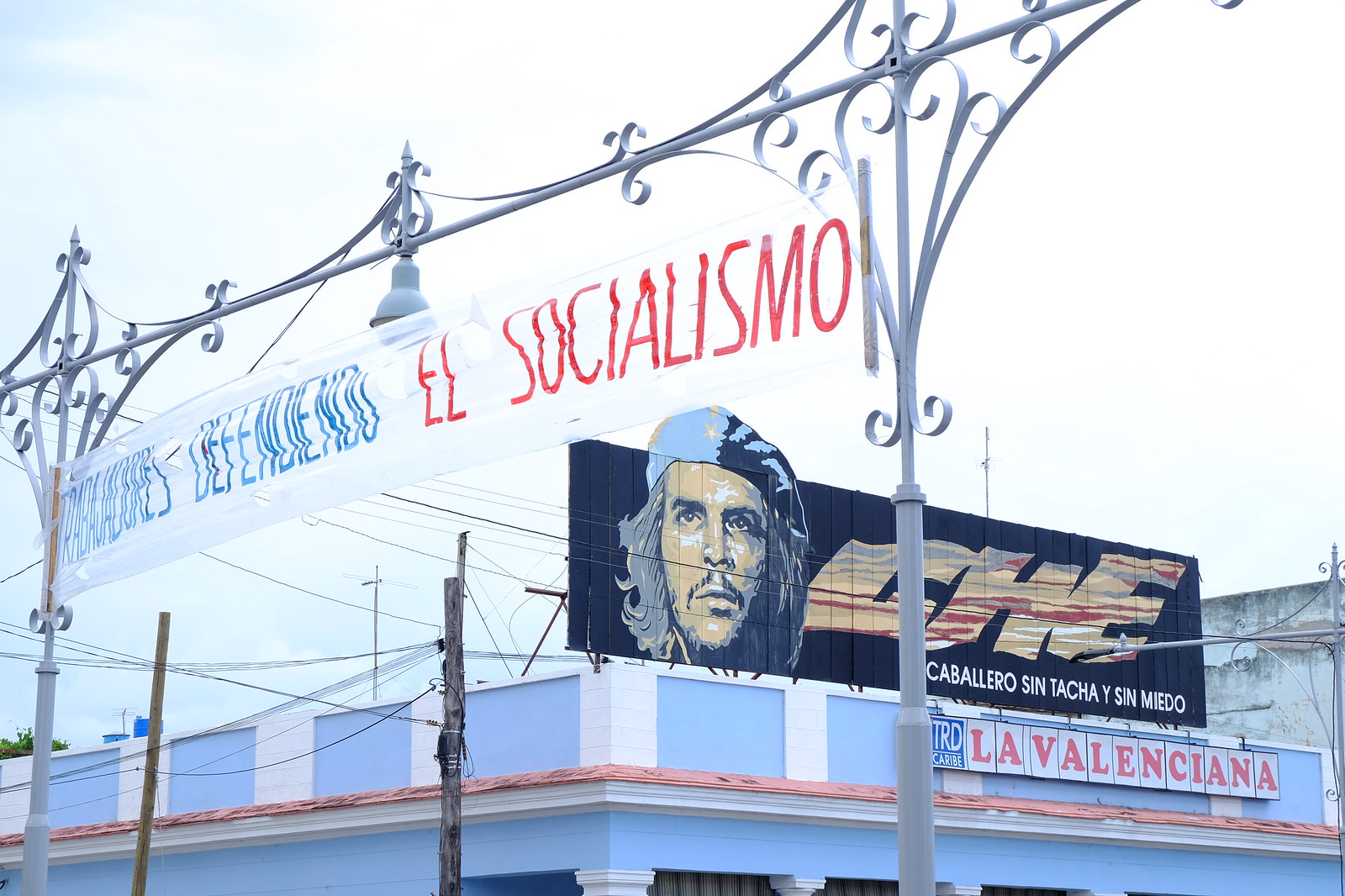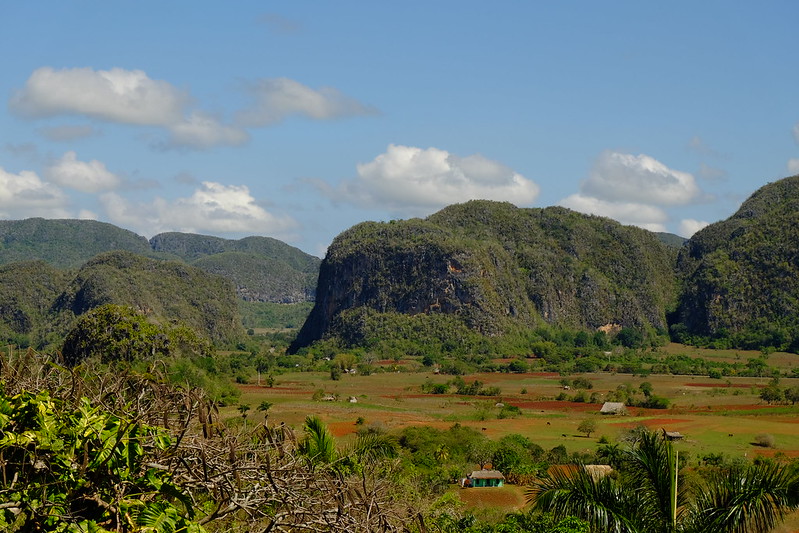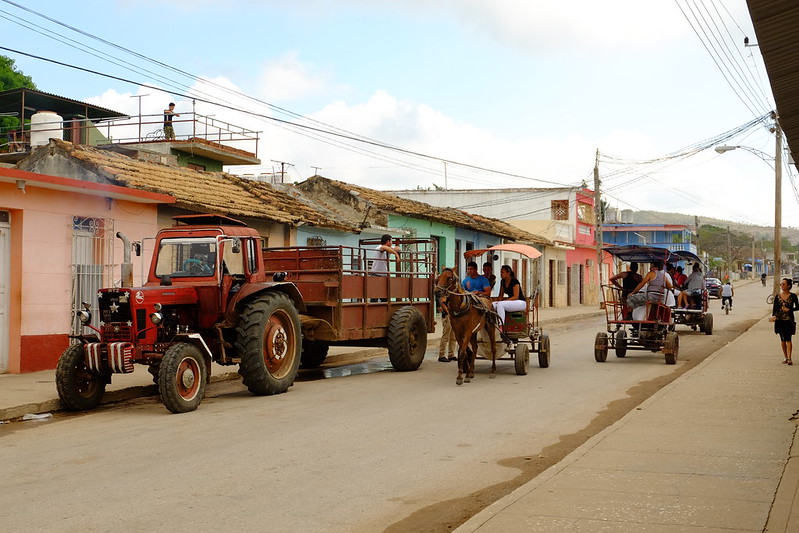While figuring out how to avoid the still-present rain to the south and meet Peter’s parents in Ecuador in a few weeks, we discovered that one can fly directly from Bogota to Havana. Hmmm. Cuba. Until recently, a place that has been off the list for legal travel all of our lives, thus making it a mysterious and nearly irresistible destination. We asked ourselves, is that the main appeal to going there, because we finally can? That’s certainly part of it, but also wrapped into the mystique is a curiosity to find out whether the rumors of a country set back in time are true. And if so, to see with our own eyes what that bygone era might have looked like. We decided to leave South America for a few weeks to check it out.
We were pretty excited about going here. We’ve been to and enjoy third world countries, and expected Cuba to fall somewhere along those lines. But upon arrival at the Havana airport, it quickly became clear that we had never been anywhere like this before. The airport is dreary, everything painted the same uninspiring drab color, with very few shops to buy very few things. And it took us nearly five hours to leave the airport. After waiting more than two hours to get our checked luggage, we found that Peter’s bag had been flagged for further inspection. Into a long line we went, concerned that maybe we shouldn’t have brought the Colombian coca tea into Cuba…. Not to worry, their concern was with a bag of dried red lentils. They wanted to know what they were, why we had them, and what we were going to do with them. My guess is they had only seen brown lentils before, never these small orange things. They looked at us skeptically as we explained more than once — in correct Spanish — that they were lentils, and we planned to cook and eat them. Finally we were released, only to stand in two more long lines to exchange some of our Euros for Cuban pesos. Euros, because you can only exchange certain currencies (Colombian pesos not being one of them), exchanging USD incurs an additional 10% fee, and exchanging money because US ATM and credit cards don’t work in Cuba.
Finally in a cab headed for the city, the airport experience quickly faded and we couldn’t stop the smiles that crept back onto our faces as we passed several of the storied old American cars. So far the rumors were very much true. And it got better: our casa particular (Cuban B&B) greeted us a welcome drink — a mojito of course! — which we sipped outside on the eleventh floor balcony while enjoying the broad sweeping view and the tropical breeze. It was a pinch-me moment, saying to each other that we’re really sitting here, in Havana! For reasons I don’t fully understand, it was very hard to believe, more so than any other place we’ve been, excepting possibly Antarctica.
Havana is wonderful. It’s yet another Spanish colonial city, but the look and feel of Havana is completely different than the other cities built by the Spanish that we’ve visited. Old Havana is crumbling in some areas, beautifully restored in others. There are lots of museums. There are more restaurants opening all the time. It’s a photographer’s paradise, especially if you’re brave enough to photograph people.
 Street performers in Old Havana
Street performers in Old Havana
 Havana Centro, next to Old Havana and mostly crumbling
Havana Centro, next to Old Havana and mostly crumbling
As our days in Havana went by, the cultural side of Cuba became more apparent to us. Everywhere we looked, there were posters, billboards and paintings of Che Guevara, Fidel Castro and/or other revolutionary heroes coupled with pro-revolution slogans. The museums painted the same picture. As I said to Peter, the Cuban government reminded me of the high school football hero whose greatest moment in life was taking your school to the state championship, and he can’t let you forget that because if you do, then you’ll realize he’s done nothing with his life since then.
 Many Russian made cars as well as old American cars
Many Russian made cars as well as old American cars
Then there are the legendary Cuban cigars. Were they as special as people say? We had to find out. Peter has smoked a few cigars, and has even gotten sick afterward, so at least he had something to use as a comparison. Luckily for us we met a couple from Atlanta who knew a lot about cigars in one of the recommended cigar shops, and they gave us the low-down on what to look and smell for in a quality cigar. We really enjoyed the afternoon tasting the local rum and (Peter) smoking a “puro,” which is what Cubans call cigars. The afternoon ended with the Atlantans inviting us along on their trip to the very fields in which the world’s most famous tobacco is grown. So, off we went the following morning in a 1952 Chevy to the picturesque Vinales Valley, only a few hours from Havana, but a world apart.
 We were in the backseat of the ’52 Chevy. We loved the bench seat, but not the springs/shocks…
We were in the backseat of the ’52 Chevy. We loved the bench seat, but not the springs/shocks…
The further we got from Havana, we realized that there is virtually no traffic in Cuba because few people can afford cars, and it feels like most of those who can use them as taxis. Instead, there are a lot of horse drawn carts. It was also amazing to see that at least some of the fields are still plowed by oxen.
 Black tobacco leaves are HUGE!
Black tobacco leaves are HUGE!
Once we arrived in Vinales, we toured two tobacco plantations where we learned that there are two primary kinds of tobacco, black and yellow. Cuba only grows black tobacco, which is generally used for cigars, whereas yellow is used for cigarettes. Also, the position of the leaf on the plant determines the nicotine content, and whether that leaf will be used as filler tobacco or as the rolling leaf. The higher the leaf on the plant, the stronger its flavor, and that is why some cigars are deliberately stronger than others. We met an 80-something man who has not only smoked four cigars a day “since he was born,” but also still rolls his own cigars.
 The house roller at the Robaina tobacco farm.
The house roller at the Robaina tobacco farm.
Back to the cigars themselves. I’ve never smoked before, but when in Rome! The short answer is yes, we agreed the hand-rolled cigars really are pretty fabulous, and if anyone offers me a smoke going forward, I can honestly say I only smoke Cubans as I decline whatever it is they are offering 🙂
 Top brand hand-rolled cigars in a Havana cigar shop.
Top brand hand-rolled cigars in a Havana cigar shop.
After Havana and the West we headed southeast to Trinidad. We are not fans of unremitting heat, and Trinidad had plenty of that on offer because it is a ten minute drive inland, and the sea breezes were lacking. But the cobblestones and old colonial architecture never got old and again the color of the buildings simply draw you in and make you happy.
The city was built by sugar plantation money and experienced its economic heyday just prior to the Haitian slave revolution that occurred in the mid-nineteenth century.
 The owner’s house on the grounds of the largest sugar cane plantation in Cuba at the height.
The owner’s house on the grounds of the largest sugar cane plantation in Cuba at the height.
With the slave revolt in Haiti, the sugar plantation owners in Trinidad folded up shop, moving their slaves and operations to the more easily defended town of Cienfuegos further west along the coast but also closer to the political capital of Havana. We spent a few days in Cienfuegos as well, which is beautiful in a completely different way because its architecture is French.
In the end, Cuba is difficult to describe concisely because it’s a multifaceted, complex place that is slowly changing. Its doubly complicated because you have to fight through your own layers of indoctrination over the past forty-some years, and it’s blatantly obvious that the Cuban people have had to, and continue to, endure their own layers of governmental indoctrination as well. You try to ignore the politics and focus on the people, but the politics are so in-your-face-all-the-time that they are impossible to ignore. Some of the people were incredibly friendly, and others seemed stand-offish and weary of tourists, considering you an extraction point. Frankly it’s kind of a weird place. You have Ernest Hemingway being exploited as much as possible for tourism, with the bars he frequented in Havana serving up diluted and overpriced mojitos. Then, you can hardly get away from Fidel Castro and Che Guevara staring down at you from a billboard as you stand on the street corner in one of the very few wifi hotspots (which are not free) with all the other Cubans, who have only recently been able to access the internet in the same way you are.
 The billboard says Che is “without fault and without fear”
The billboard says Che is “without fault and without fear”
The country makes the world’s finest cigars and some of the finest rum, but you have to be careful when eating your rice in a nice restaurant so as not to break a tooth on an errant stone. In the end, we are very glad we went, but two weeks was enough for us. If you go to Cuba we highly recommend that you venture outside of Havana to get a better sense of this complicated country. We’re still thinking about all we saw there, trying to put it all together.
For more photos, click through here:


























1 reply